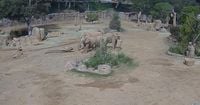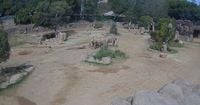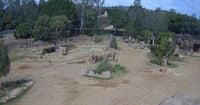On Monday morning, April 14, 2025, a 5.2 magnitude earthquake struck Southern California, sending tremors felt from San Diego to Los Angeles and even as far as Tijuana, Mexico. The quake, which occurred around 10 a.m. with its epicenter near Julian, Calif., prompted a remarkable response from the elephants at the San Diego Zoo Safari Park, located approximately 40 minutes north of the city.
Captured on video, the elephants instinctively formed an "alert circle" to protect their young calves, Zuli and Mkhaya, both just seven years old. The adult elephants, Ndlula, Umngani, and Khosi, quickly surrounded the calves, demonstrating a behavior typical of elephants when they sense danger. According to Mindy Albright, a curator of mammals at the park, this protective instinct showcases the strong social bonds within elephant herds.
As the ground shook, the elephants huddled together, flapping their ears and assessing their surroundings. This defensive formation lasted for about four minutes after the initial tremor. Albright explained, "When something alarming happens, like a predator or an earthquake, they surround the young to protect them from danger—this is called an 'alert circle.'" The elephants' ability to feel sound through their feet allows them to detect vibrations that humans cannot, further enhancing their response to environmental threats.
The earthquake, linked to the Elsinore Fault system, was recorded at a depth of about eight miles beneath the surface. While the quake caused some minor disruptions—such as items falling off shelves in local stores and boulders rolling onto rural roads—there were no reported injuries or significant damage. However, the elephants were visibly affected, as they huddled together during an aftershock about an hour later before returning to their normal activities.
In the video footage, the herd's dynamics were on full display. Mkhaya instinctively sought refuge in the center of the circle, while Zuli, the only male calf, positioned himself at the edge, seemingly eager to assert his independence. Albright noted that Khosi, a teenage female elephant who helped raise Zuli, was seen gently tapping him with her trunk as if to reassure him, saying, "Things are OK," and encouraging him to stay within the protective circle.
This isn't the first time the elephants at the San Diego Zoo Safari Park have demonstrated such behavior. In 2010, during a 7.2 magnitude earthquake that shook the Baja California area, the elephants similarly formed an alert circle. This repeated behavior underscores the elephants' strong familial instincts and their ability to adapt to perceived threats.
Dr. Joyce Poole, a conservation biologist and expert on elephant behavior, explained that when elephants bunch together, they feel more secure and can better survey their environment for potential dangers. In the wild, this behavior is critical for the survival of the herd, particularly for the youngest members, who instinctively seek the most protected positions. "They detect that animals are running, and therefore there is something potentially to be fearful of," Poole stated.
Albright emphasized the importance of such responses in understanding elephant behavior and health. "For them to just be so in tune with their environment and paying attention to the environmental cues, it’s really something that you want to see them still hone in on. It’s a measure of their health to see them respond like this," she said.
The San Diego Zoo Wildlife Alliance noted that this incident illustrates the strong social structure within elephant herds. Elephants are known for their complex social bonds and communication skills, which play a vital role in their survival. As they continue to adapt to their environment, their responses to threats like earthquakes provide valuable insights into their behavior and social dynamics.
In summary, the earthquake on April 14 not only shook the ground beneath Southern California but also highlighted the remarkable instincts and social behaviors of elephants at the San Diego Zoo Safari Park. Their quick formation of an alert circle to protect their young is a testament to their intelligence and strong family ties, offering a glimpse into the intricate lives of these majestic animals.
As the elephants returned to their daily routines after the quake, they served as a reminder of the importance of family and protection in the animal kingdom—a lesson that resonates with many, human and animal alike.







